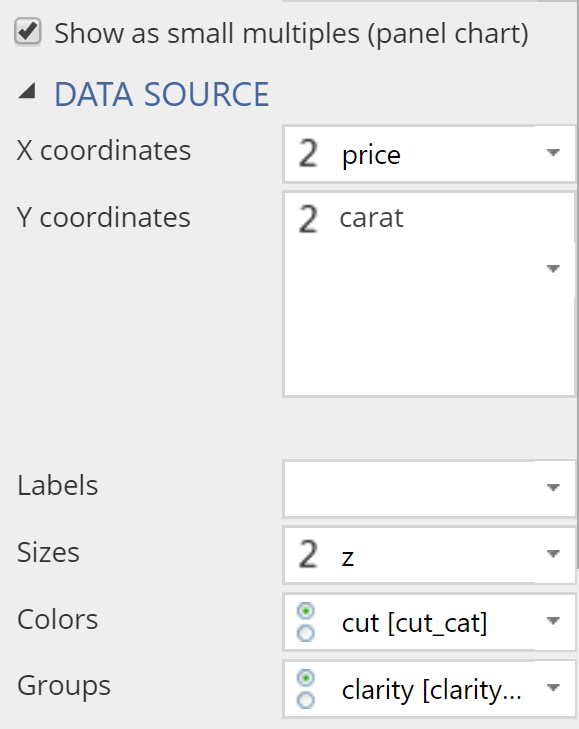Visualization - Scatter - Small Multiples Scatter
The Small Multiples - Scatterplot feature creates a panel of scatterplots, grouping the plots based on a selected variable.
Examples
The following example shows the relationship between the price of a diamond and its mass (carat). The quality of the cut is color-coded and the depth of the diamond is represented by the size of the dot. The plots are divided into small multiples based on the clarity of the diamond.
 |
Create a Small Multiples Scatterplot in Displayr
- 1. Go to Insert > Visualization > Small Multiples > Scatterplot
- 2. Under Inputs > DATA SOURCE > X coordinates, select the variable you wish to be displayed horizontally
- 3. Under Inputs > DATA SOURCE > X coordinates, select the variables you wish to be displayed vertically
- 4. [OPTIONAL] Under Inputs > DATA SOURCE > Sizes and Colors, select variables to alter the sizes and colors of the dots.
- 5. Under Inputs > DATA SOURCE > Groups, select the variable used to divide your data into panels.
Object Inspector Options
The following is an explanation of the options available in the Object Inspector for this specific visualization. Refer to Visualization Options for general chart formatting options.
Inputs
DATA SOURCE
The expected input format to create a Small Multiples - Scatterplot is similar to for Scatterplots with multiple groups (colors variables treated as categories). In fact you should be able to toggle between these charts. The last column of the linked or pasted table will be converted to categories and used to separate the data into different panels. The remaining columns are used as the variables to control 1) x-coordinates, 2) y-coordinates, 3) scatter point sizes and 4) scatter point colors if they are present. If the data is input as variables, the Groups variable will be used to separate the data into different panels. In scatterplot small multiples, the colors variable is always treated as numeric.
DATA MANIPLULATION
Input data contains y-values in multiple columns. When this is selected, the data in each column of the input table is treated as y-coordinates in a separate panel. The x-coordinates will be taken from the rownames of the table.
More Information
Code
{
"formChartType": "Scatter",
"formStackSeries": true,
"formSmallMultiples": true,
"formAsPercentages": false,
"formScatterLabelType": "As hover text"
}